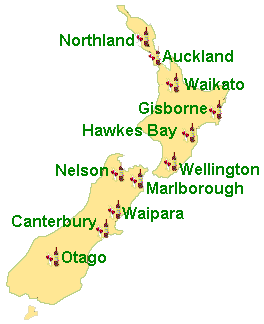
NEW ZEALAND'S WINE PRODUCING REGIONS

Northland
Winemaking in Northland has undergone rapid expansion in recent years after nearly dying out, although it still rates as the country's smallest region. Overall, this region experiences the warmest ripening conditions, very suitable for Cabernet Sauvignon, Merlot and Chardonnay. The vineyards are sited mainly on gentle slopes or flats on a variety of soils ranging from shallow clay to free draining volcanic soils.
Auckland
Auckland has several of the oldest wineries in the country. A flourishing Dalmation community was responsible for setting up some of the first commercial wineries in New Zealand. This area is good for ripening grapes as the area is warm with high degree days. High autumn rains can be a problem in some areas. Cabernet sauvignon based reds are very important here.
Waikato
One of the earliest wine-producing areas, but with the southwards drift in viticulture, the area planted in vines has plummeted. Less than 3% of the nations vineyards remain here. Grape yields are lower in the Waikato’s clay soils than in the fertile Gisborne plains and although temperatures and sunshine are high, the average rainfall and humidity is a decided handicap. The outlook is bleak for Waikato’s viticultural future. Principal grapes grown include chardonnay, riesling and cabernet sauvignon.
Gisborne
Gisborne is the wine industry’s ‘bread basket’, the primary source of bulk grapes for the cask production lines. Here the climate is roughly between that of Auckland and Hawkes Bay. The autumn rains are a little high. It is a good growing area for muller thurgau but chardonnay and gewurztraminer do well also. In fact this region produces about one third of the national crop of chardonnay grapes and has developed a reputation as "Chardonnay Capital of New Zealand."
Hawkes Bay
One of New Zealand’s pioneer winemaking regions, Hawkes Bay has retained its traditional importance. The summers and autumns are generally dry and the soils fertile and free draining. This is one of our best areas for producing fine wines such as cabernet sauvignon, merlot, syrah and chardonnay. The second largest grape growing area in the country. The Gimblett Gravels area covering 800ha, is a special terroir located within this region, produces some of the world's finest full bodied red wines.
Wellington
This area (originally known as Martinborough or Wairarapa) has emerged in a remarkably short space of time as one of New Zealand’s most prestigious winegrowing regions. It is the coolest of the North Island’s winegrowing regions but it is also the driest and escapes some of the late summer and autumn rains that cause problems in Gisborne and Hawkes Bay. The first modern era Wellington wines were bottled in 1984; since then the flow of chardonnays, rieslings, pinot noirs and other varieties has been of exciting quality. It arguably produces some of New Zealand’s finest red wines.
Marlborough
The emergence of Marlborough as the country’s most heavily planted wine region rates among the most crucial developments of the last 30 years. It accounts for an impressive 75% of the countries total wine production. It is also home to the internationally acclaimed 'Marlborough Sauvignon Blanc' that has been instrumental in helping put Marlborough in the global spotlight. Its current planted area produces in a good year over 200,000 tonnes of grapes. The main varietals under production are Sauvignon Blanc, Chardonnay, Pinot Noir and Riesling. Other popular varietals grown in smaller quantities include Pinot Gris, Gewurztraminer, Merlot and Cabernet Sauvignon. It produces New Zealand's finest methode champenoise wines. Marlborough is one of New Zealand's sunniest and driest areas.
Nelson
The advantages of this area’s warm summers and high sunshine hours are slightly reduced by the risk of damaging autumn rains as harvest approaches. In this respect Nelson parallels most North Island wine districts more closely than other South Island regions. Although only producing a small amount of New Zealand’s wines it still has a good reputation for some excellent rieslings, pinot gris and chardonnays.
Waipara
This relatively new viticultural area lying 45k to the north of Christchurch was first planted in vines in the early 1980’s. The low rainfall and long, hot, dry days (sheltered from the Pacific’s cool easterly breezes) aid the ripening of the principal grapes grown - Pinot Noir, Chardonnay, Riesling, Sauvignon Blanc and Pinot Noir. The soil, predominantly of limestone origin, is excellent for these varieties.
Canterbury
The vineyards of Canterbury are concentrated mainly on the plains south-west of Christchurch with a token presence on Banks Peninsula. The temperatures are significantly cooler than Marlborough, with a high risk of spring and autumn frosts. However, the region's saving grace is the low rainfall, with particularly long dry autumns, allowing the grapes to ripen slowly and maintain good levels of acidity. Late-ripening grapes do not fare so well, while current plantings prove the potential for pinot noir, chardonnay and riesling along with pinot gris.
Otago
Here are to be found what are probably the southernmost commercial vineyards in the world. There is a steadily increasing amount of land being planted in grapes, with over 1500ha now in production. The vines are grown in Central Otago which is a region of climatic extremes. Summer is typically hot, autumn short and winter icy-cold. Only the most carefully selected sites have enabled winemakers to succeed here. Pinot noir and riesling are two varieties which have done particularly well as well as some chardonnay.